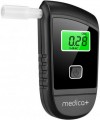Warm-up time
The warm-up time of the breathalyzer to the working state, in other words, the time that must pass after switching on or after the end of the previous measurement before the device can be used.
The fastest modern breathalyzers warm up in 5 – 6 seconds, time
up to 20 seconds is considered quite good; in
slower models, this time can be up to a minute. At the same time, it makes sense to specifically look for a device with a short warm-up time only in cases where it is needed for streaming checks and high speed is crucial. And if the device is purchased for individual use with measurements a maximum of 2 – 3 times a day — you can not pay much attention to this parameter: waiting even a few tens of seconds is most often not a problem.
Blow time
The blowing time is the shortest time during which you need to blow into the device for effective measurement. The shorter this time, the more sensitive and advanced the breathalyzer is, the simpler the measurement procedure and the less time it will take; the fastest modern appliances purge
in 3 seconds or less. On the other hand, a short blowing time affects the cost. Therefore, if the device is not planned to be used for mass streaming checks, this parameter can be ignored.
Tests counter
Built-in counter that records the number of measurements taken. The features of the operation of such a
counter can be different — in particular, it can count from the beginning of the day, from the moment it was turned on, from the moment the sensor was last calibrated, etc. These details should be clarified separately. Anyway, the meaning of this function lies in the fact that most breathalyzers have restrictions on the number of measurements per day, and without automatic counting, it can be difficult to monitor compliance with these restrictions. In addition, the calibration and maintenance of the sensor also needs to be done after a certain number of measurements.
Last measurements memory
Ability to save the results of the last few measurements in the
memory of the device. The number of available saves can be different, as well as their storage time: in some devices, the saved results are erased when turned off, in others they are stored until they are erased or overwritten. Anyway, the memory of the last measurements is useful mainly for streaming checks.
Power source
Type of power supplied by the device. The power supply methods used in modern breathalyzers can be divided into two types — replaceable cells of a standard size and original batteries.
The first option is convenient because dead batteries can be quickly replaced with fresh ones — the main thing is to have a supply on hand. At the same time, replaceable elements can be made both disposable and rechargeable, in the form of batteries. On the other hand, batteries usually have to be purchased separately — and either regularly buy more disposable cells, or spend a significant amount on batteries and a charger. Here are the main sizes of replaceable elements found in modern breathalyzers:
— AAA. Cylindrical-shaped batteries, known as "mini finger" or "little finger" batteries. A fairly popular option, especially among entry-level and mid-level breathalyzers: they are small in size, and although the capacity of such batteries is small, it is quite enough for the mentioned devices.
— AA. Classic, known to many "finger" batteries. For a number of reasons (in particular, due to the larger size), they are used in breathalyzers less frequently than the “little finger” AAA.
— PP3. Batteries of a characteristic rectangular shape with a pair of contacts on one of the ends. They are distinguished by a rather high voltage — 9 V. They are used mainly in professional devices with an abundance of additional functions that require a large amount of energy.<...br>
As for the original batteries, such batteries often outperform replacement batteries in terms of performance and do not require additional costs: the battery is purchased immediately with the device and in the future it is enough to periodically recharge it. On the other hand, charging requires time and a power source; it is usually impossible to quickly replace a dead battery. And the mentioned performance advantages are rarely decisive. As a result, this variant is relatively rare in breathalyzers.

